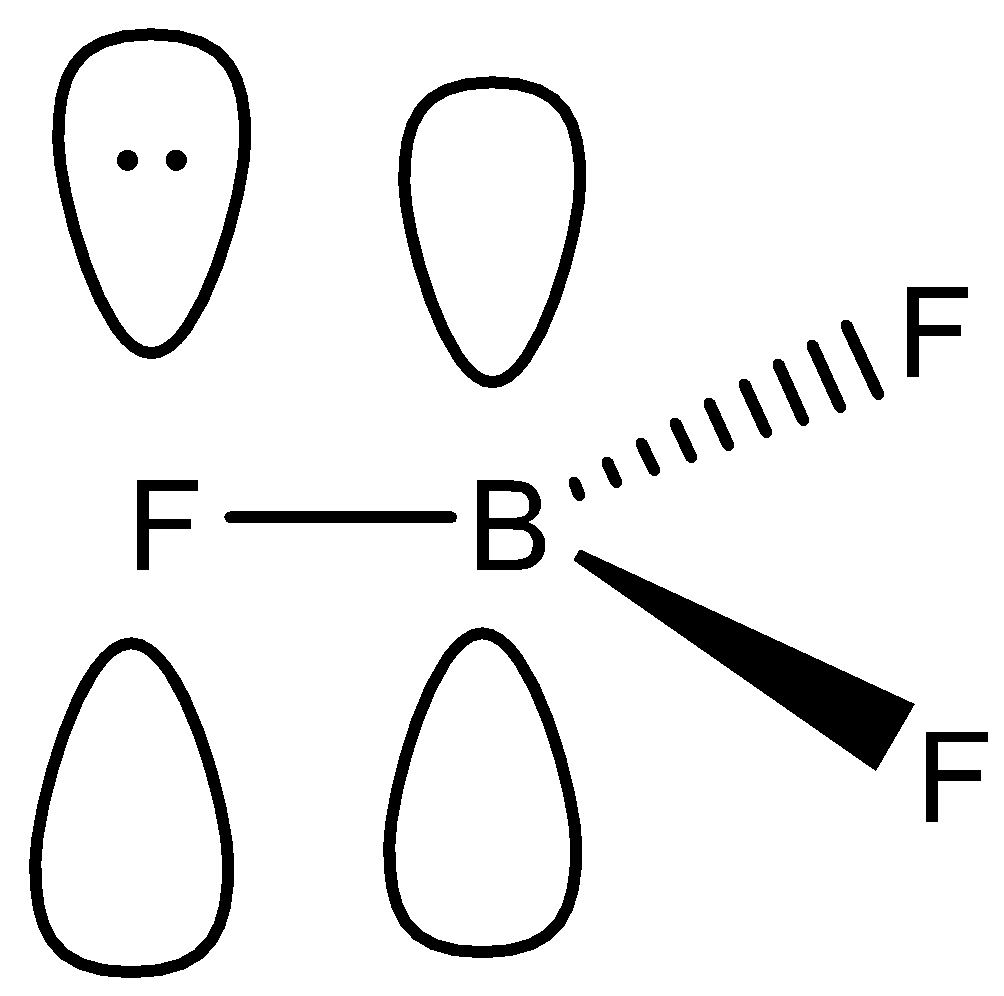
In ${\text{B}}{{\text{F}}_{\text{3}}}$, the B-F bond length is 1.30 A. When ${\text{B}}{{\text{F}}_{\text{3}}}$ is allowed to react with ${\text{M}}{{\text{e}}_{\text{3}}}{\text{N}}$, it forms an adduct, ${\text{M}}{{\text{e}}_{\text{3}}}{\text{N}} \to {\text{B}}{{\text{F}}_{\text{3}}}$. The bond length of B-F in the adduct is:
A. Greater than 1.30 A
B. Smaller than 1.30 A
C. Equal to 1.30 A
D. None of these
Answer
487.2k+ views
Hint: In this question, we will consider the concept of back bonding in the case of ${\text{B}}{{\text{F}}_{\text{3}}}$. Back bonding happens between the atom having lone pair of an electron, whereas the other atom has a vacant orbital, a pi bond will be formed. Back bonding affects the bond length, but when an adduct is formed there will be no back bonding.
Complete step by step answer:
-First, we will discuss the back bonding in the case of ${\text{B}}{{\text{F}}_{\text{3}}}$ molecule.
-In this molecule, boron and fluorine both contains an empty p-orbital, whereas the p-orbital of fluorine contains a lone pair of electrons as shown:

-Now, in this case, fluorine will donate its lone pair to the boron, and there will be the formation of a pi bond as mentioned. We know that this is also known as back bonding.
-If we talk about the bond length, then back bonding leads to the decrease in bond length, but the bond angle remains the same.
-We can say that double bond characteristics are being imparted with back bonding.
-As we know, when ${\text{B}}{{\text{F}}_{\text{3}}}$ reacts with the ${\text{M}}{{\text{e}}_{\text{3}}}{\text{N}}$, it forms an adduct.
-Thus, in the adduct, there will be no back bonding, and the double bond characteristics disappear.
-We can say that the no longer presence of back bonding in the molecule will lead to an increase in the bond length.
-So, in the end, we can conclude that the bond length of the B-F bond in the adduct will be greater than 1.30 due to the absence of back bonding.
Hence, the correct option is A.
Note: There could be confusion as to why fluorine donates its lone pair to the boron. Then, we have seen that the fluorine contains a lone pair in its orbital, and it will act as a Lewis base. The other important point is that when an adduct is formed, there will be no pi-bond, it will again form a sigma bond. That’s why the bond length is greater than 1.30 A.
Complete step by step answer:
-First, we will discuss the back bonding in the case of ${\text{B}}{{\text{F}}_{\text{3}}}$ molecule.
-In this molecule, boron and fluorine both contains an empty p-orbital, whereas the p-orbital of fluorine contains a lone pair of electrons as shown:

-Now, in this case, fluorine will donate its lone pair to the boron, and there will be the formation of a pi bond as mentioned. We know that this is also known as back bonding.
-If we talk about the bond length, then back bonding leads to the decrease in bond length, but the bond angle remains the same.
-We can say that double bond characteristics are being imparted with back bonding.
-As we know, when ${\text{B}}{{\text{F}}_{\text{3}}}$ reacts with the ${\text{M}}{{\text{e}}_{\text{3}}}{\text{N}}$, it forms an adduct.
-Thus, in the adduct, there will be no back bonding, and the double bond characteristics disappear.
-We can say that the no longer presence of back bonding in the molecule will lead to an increase in the bond length.
-So, in the end, we can conclude that the bond length of the B-F bond in the adduct will be greater than 1.30 due to the absence of back bonding.
Hence, the correct option is A.
Note: There could be confusion as to why fluorine donates its lone pair to the boron. Then, we have seen that the fluorine contains a lone pair in its orbital, and it will act as a Lewis base. The other important point is that when an adduct is formed, there will be no pi-bond, it will again form a sigma bond. That’s why the bond length is greater than 1.30 A.
Recently Updated Pages
The correct geometry and hybridization for XeF4 are class 11 chemistry CBSE

Water softening by Clarks process uses ACalcium bicarbonate class 11 chemistry CBSE

With reference to graphite and diamond which of the class 11 chemistry CBSE

A certain household has consumed 250 units of energy class 11 physics CBSE

The lightest metal known is A beryllium B lithium C class 11 chemistry CBSE

What is the formula mass of the iodine molecule class 11 chemistry CBSE

Trending doubts
Is Cellular respiration an Oxidation or Reduction class 11 chemistry CBSE

In electron dot structure the valence shell electrons class 11 chemistry CBSE

What is the Pitti Island famous for ABird Sanctuary class 11 social science CBSE

State the laws of reflection of light

One Metric ton is equal to kg A 10000 B 1000 C 100 class 11 physics CBSE

Difference Between Prokaryotic Cells and Eukaryotic Cells




